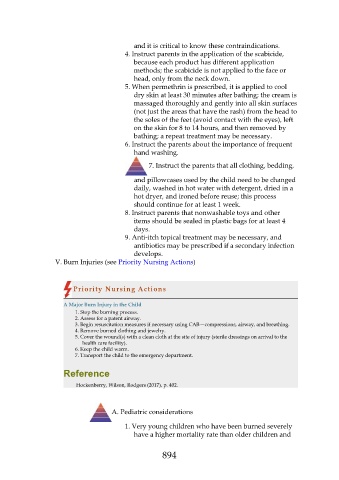Page 894 - Saunders Comprehensive Review For NCLEX-RN
P. 894
and it is critical to know these contraindications.
4. Instruct parents in the application of the scabicide,
because each product has different application
methods; the scabicide is not applied to the face or
head, only from the neck down.
5. When permethrin is prescribed, it is applied to cool
dry skin at least 30 minutes after bathing; the cream is
massaged thoroughly and gently into all skin surfaces
(not just the areas that have the rash) from the head to
the soles of the feet (avoid contact with the eyes), left
on the skin for 8 to 14 hours, and then removed by
bathing; a repeat treatment may be necessary.
6. Instruct the parents about the importance of frequent
hand washing.
7. Instruct the parents that all clothing, bedding,
and pillowcases used by the child need to be changed
daily, washed in hot water with detergent, dried in a
hot dryer, and ironed before reuse; this process
should continue for at least 1 week.
8. Instruct parents that nonwashable toys and other
items should be sealed in plastic bags for at least 4
days.
9. Anti-itch topical treatment may be necessary, and
antibiotics may be prescribed if a secondary infection
develops.
V. Burn Injuries (see Priority Nursing Actions)
Priority Nursing Actions
A Major Burn Injury in the Child
1. Stop the burning process.
2. Assess for a patent airway.
3. Begin resuscitation measures if necessary using CAB—compressions, airway, and breathing.
4. Remove burned clothing and jewelry.
5. Cover the wound(s) with a clean cloth at the site of injury (sterile dressings on arrival to the
health care facility).
6. Keep the child warm.
7. Transport the child to the emergency department.
Reference
Hockenberry, Wilson, Rodgers (2017), p. 402.
A. Pediatric considerations
1. Very young children who have been burned severely
have a higher mortality rate than older children and
894

